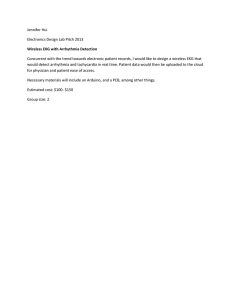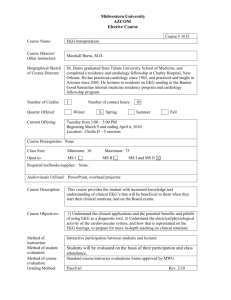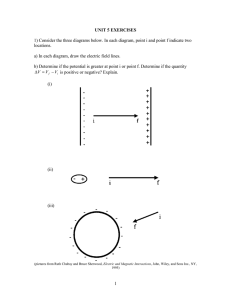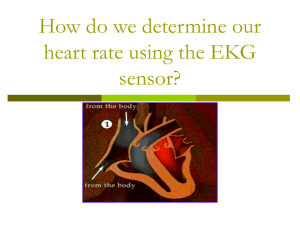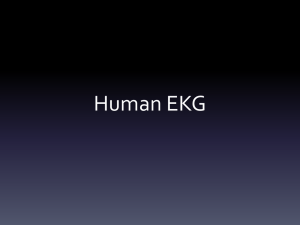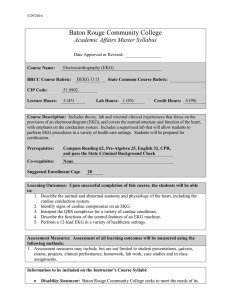Development and Evaluation of a Bluetooth EKG
advertisement
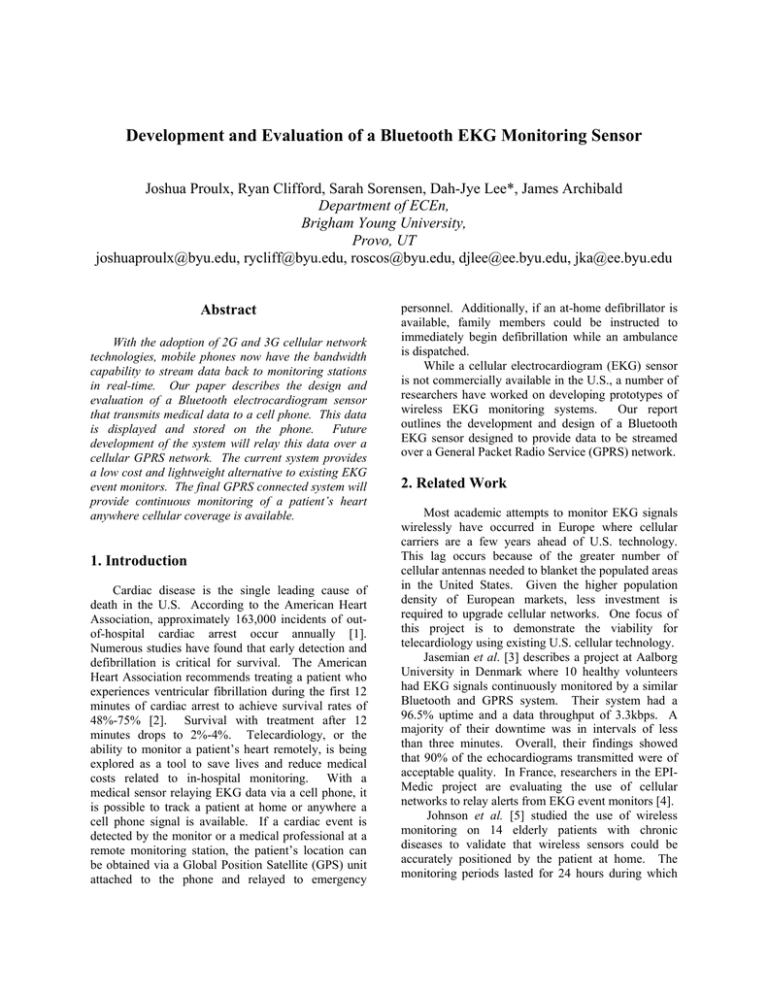
Development and Evaluation of a Bluetooth EKG Monitoring Sensor Joshua Proulx, Ryan Clifford, Sarah Sorensen, Dah-Jye Lee*, James Archibald Department of ECEn, Brigham Young University, Provo, UT joshuaproulx@byu.edu, rycliff@byu.edu, roscos@byu.edu, djlee@ee.byu.edu, jka@ee.byu.edu Abstract With the adoption of 2G and 3G cellular network technologies, mobile phones now have the bandwidth capability to stream data back to monitoring stations in real-time. Our paper describes the design and evaluation of a Bluetooth electrocardiogram sensor that transmits medical data to a cell phone. This data is displayed and stored on the phone. Future development of the system will relay this data over a cellular GPRS network. The current system provides a low cost and lightweight alternative to existing EKG event monitors. The final GPRS connected system will provide continuous monitoring of a patient’s heart anywhere cellular coverage is available. 1. Introduction Cardiac disease is the single leading cause of death in the U.S. According to the American Heart Association, approximately 163,000 incidents of outof-hospital cardiac arrest occur annually [1]. Numerous studies have found that early detection and defibrillation is critical for survival. The American Heart Association recommends treating a patient who experiences ventricular fibrillation during the first 12 minutes of cardiac arrest to achieve survival rates of 48%-75% [2]. Survival with treatment after 12 minutes drops to 2%-4%. Telecardiology, or the ability to monitor a patient’s heart remotely, is being explored as a tool to save lives and reduce medical costs related to in-hospital monitoring. With a medical sensor relaying EKG data via a cell phone, it is possible to track a patient at home or anywhere a cell phone signal is available. If a cardiac event is detected by the monitor or a medical professional at a remote monitoring station, the patient’s location can be obtained via a Global Position Satellite (GPS) unit attached to the phone and relayed to emergency personnel. Additionally, if an at-home defibrillator is available, family members could be instructed to immediately begin defibrillation while an ambulance is dispatched. While a cellular electrocardiogram (EKG) sensor is not commercially available in the U.S., a number of researchers have worked on developing prototypes of wireless EKG monitoring systems. Our report outlines the development and design of a Bluetooth EKG sensor designed to provide data to be streamed over a General Packet Radio Service (GPRS) network. 2. Related Work Most academic attempts to monitor EKG signals wirelessly have occurred in Europe where cellular carriers are a few years ahead of U.S. technology. This lag occurs because of the greater number of cellular antennas needed to blanket the populated areas in the United States. Given the higher population density of European markets, less investment is required to upgrade cellular networks. One focus of this project is to demonstrate the viability for telecardiology using existing U.S. cellular technology. Jasemian et al. [3] describes a project at Aalborg University in Denmark where 10 healthy volunteers had EKG signals continuously monitored by a similar Bluetooth and GPRS system. Their system had a 96.5% uptime and a data throughput of 3.3kbps. A majority of their downtime was in intervals of less than three minutes. Overall, their findings showed that 90% of the echocardiograms transmitted were of acceptable quality. In France, researchers in the EPIMedic project are evaluating the use of cellular networks to relay alerts from EKG event monitors [4]. Johnson et al. [5] studied the use of wireless monitoring on 14 elderly patients with chronic diseases to validate that wireless sensors could be accurately positioned by the patient at home. The monitoring periods lasted for 24 hours during which 90% of the patient’s EKG was properly recorded. They found no significant difference in signal quality compared to when a nurse positioned the sensors. Significant abnormalities previously undetected by medical professionals were captured by the continuous monitoring system. Japanese researchers also demonstrated the superiority of wireless sensors. Traditional wired electrodes are strained by tension caused by patient movement and tangled lead wires. This “spaghetti syndrome” was found to hinder data capture from wired electrodes when compared to wireless leads used in the study. At the same time, the wireless leads were shown to give quality signals that medical professionals could use to diagnose conditions [6]. EKG Sensor Analog-to-Digital Converter 3. Prototype Design The hardware and software utilized for our prototype is detailed below. In Figure 1 the flow of data from the EKG sensor is given. The EKG sensor is attached to the patient with three leads, two on the chest, and one on the left leg or in an alternative configuration with the leads attached on the arms. The sensor outputs an analog signal which is then converted by the analog-to-digital converter (ADC). The serial-to-Bluetooth module transmits the digital output of the ADC to the cell phone. On the phone the sampled EKG is displayed and stored. The next stage of development for our prototype will be to implement code to relay the EKG data via GPRS and evaluate the transmission to a website via the cellular network. Once this final stage is completed we will evaluate the battery life of the cell phone and uplink reliability. While current GPRS technology has sufficient bandwidth in theory to stream the EKG data uncompressed from our sensor, we will determine whether compression of the data is required. Previous work to implement a zonal wavelet-based compression algorithm to compress EKG data is described by Istepanian et al. [7]. Their method provides up to 18:1 compression of the signal. Serial-to-Bluetooth Module EKG Data Flow 3.1. Hardware Our Bluetooth EKG sensor includes a 3-lead EKG circuit produced by Vernier Technologies. While it is not approved by the Food and Drug Administration for medical use, the device is manufactured for academic and educational capturing of EKG signals. The EKG sensor measures differential voltages on the chest and on the left leg or in an alternate configuration on both arms. Once the signal is amplified, it is outputted in analog form as a signal ranging from 0 to 3.6Vdc. Figure 1. Diagram showing flow of EKG data Our analog-to-digital converter samples the output from the Vernier sensor. We are using the MAXQ3120 microprocessor manufactured by Maxim Integrated Products. The microprocessor runs at 8MHz and samples the analog signal at a frequency rate of 125Hz with 14-bits per sample. This frequency and sample resolution is comparable to commercial EKG units. The MAXQ3120 development board requires a 3.3-5Vdc power supply from which it produces an internal 3.3Vdc power supply to the chip. Since the MAXIM chip measures voltages from 01Vdc, the output from the Vernier board is put through a voltage divider to allow the chip to sample the full range of EKG signals. The output from the MAXIM chip is sent via a 3.3Vdc TTL voltage-level serial line. On the MAXQ3120 development board the TTL serial signal is also converted to a standard RS-232 voltagelevel serial line by the MAX3160C chip. This RS-232 interface allows for direct monitoring of the EKG samples by a desktop computer. The Bluetooth module we chose is part MTS2BTSMI-L manufactured by Multi-Tech Systems, Inc. It utilizes a Class 1 Bluetooth chip which is also powered by 3.3Vdc. The module accepts serial data up to 920Kbps. The serial port runs at 3.3Vdc TTL voltage-level with a buffer of 50 bytes and hardware flow control. The maximum Bluetooth transmission rate is 60Kbps in standard mode and 200Kbps in fast data mode. Attached to the Bluetooth module is a 2.4-2.5GHz half-wave dipole antenna with a 2 dBi gain. Table 1. Bluetooth module and antenna specifications Bluetooth module Bluetooth Class Class 1 Voltage 3.3Vdc Frequency Range 2402-2480Mhz Modulation FHSS/GFSK Channel Intervals 1Mhz Number of Channels 79 Transmission Rate 721Kbps Output Level 20 dBm maximum RF Receive Sensitivity -80 dBm typical Bluetooth Timeout 4 seconds Flow Control Hardware (RTS/CTS) Serial Speeds 1200bps to 920Kbps Buffer 50 bytes Encryption 56 bit Antenna Frequency Range 2.4-2.5Ghz Impedance 50 ohm nominal VSWR <2.0:1 Gain 2 dBi Radiation Omni Polarization Vertical Wave Half-wave dipole For the cell phone we used a Nokia 3650. This model was selected for its versatility in hardware and software. Like many other Nokia phones, it runs the Symbian operating system with applications coded in either C or Java. The 3650 has the ability to store data on a removable MMC storage card. With the capability to connect to Bluetooth devices, this phone is able to capture EKG data from the wireless sensor. Since the phone is compatible with Global System for Mobile Communications (GSM) networks, it can connect to the GPRS networks available in the U.S. from cellular carriers TMobile and Cingular. In the future, GPRS connectivity will be used to relay data from the phone to a monitoring web site. The total cost for the sensor exclusive of the cell phone is approximately $250 which is much lower than the retail price of existing non-wireless EKG event monitors that sell for $1500-$3000. The Nokia 3650 cell phone used costs about $400 but is generally free with activation of a cellular account. Once GPRS connectivity is implemented, the cost for a web server and GPRS connection is about $22 per month. 3.2. Software On the Nokia 3650, we had the option of writing the cell phone client software in either C or Java. While both languages are capable of connecting to the Bluetooth stack and interfacing the web via GPRS, Java applications are halted if the user receives an incoming call or loads another application. Writing our code in C allowed our program to continue to capture data from the EKG sensor in the background regardless of what task the cell phone has in the foreground. To develop the code, we used Microsoft Visual Studio .NET Edition with the Nokia Series 60 SDK. An additional Nokia program, Carbide.vs, is installed which allows us to emulate and debug the software on a desktop. A screenshot of the cell phone emulator is given in Figure 2. Compiled code for the cell phone was packaged into a Symbian .SIS installation file and transmitted to the phone via Bluetooth. Figure 2. Software emulation on PC Once downloaded to the phone, the .SIS file initiates installation of the Wireless EKG client software. The program is then accessible by the main menu on the phone. After launching the client, the phone initiates discovery and paring with the Bluetooth module. Data is then received from the EKG sensor through a virtual serial port set up by the Bluetooth connection. As the EKG data arrives on the phone, the packets are stored and analyzed. Each packet contains the high byte and low byte of the 14bit EKG sample as seen in Figure 3. After reassembling one EKG sample the EKG graph on the cell phone display is updated. Bit 1 2 3 4 5 6 7 8 9 10 11 12 13 14 15 16 17 18 19 20 21 22 23 24 Purpose unconnected. Otherwise the 50 byte buffer overflows preventing a future Bluetooth connection. 4. Evaluation The three leads were attached to the arms in the following configuration: positive to upper left arm, negative to upper right arm, and ground to lower right arm. During initial development the Vernier EKG sensor was powered from a 5Vdc AC-to-DC adapter. We found that using power from an AC-to-DC transformer caused a 60Hz signal to be linearly added to the resulting EKG signal. This non-filtered signal from the household current can be seen in the horizontal portions of the EKG signal in Figure 4. Header Data Unused MSB Figure 4. Sampled EKG signal 4.1. Transmission EKG Sample Data LSB Figure 3. Packet containing one EKG sample The embedded code for the MAXIM microprocessor was written in assembly using the MAX-IDE development software included with the MAXQ3120 development board. The compiled code was programmed onto the chip using a standard Joint Test Action Group (JTAG) interface board. The microprocessor code uses the internal timers to sample the EKG signal at 125Hz. With each 14-bit sample a packet is created and then sent to the serial output. The microprocessor code also monitors the Bluetooth connection to ensure that data is not streamed when With the MAXIM microprocessor sampling at 125Hz and each sample being sent in a three byte packet, the microprocessor sends 3,000 bytes per second to the Bluetooth module. The serial line is configured with one start bit, no parity, and one stop bit yielding a 30kbps data transmission rate. This utilizes 26% of the available bandwidth of the 115.2kbps serial line. Since the Bluetooth module only supports hardware flow control and the MAXQ3120 does not provide RTS/CTS pins for the serial interface, it is possible to overflow the 50 byte buffer on the Bluetooth module. As documented in the Bluetooth module’s specification sheet, random byte gaps of 5ms to 20ms are common for Bluetooth transmission. However these byte gaps are not large enough to overflow the module during normal operations when the EKG sensor samples at 125Hz. Byte gaps of 133ms or more are required in order to cause buffer overflow when sampling at 125Hz. Gaps of that size are not seen unless the Bluetooth connection requires a significant number of retransmissions. This generally occurs only when transmitting long distances. 4.2. Sensor Range The range for the Class 1 Bluetooth module was found to be 100 meters when a line-of-sight contact is established between the cell phone and wireless sensor. For transmissions with one six-inch brick wall between the cell phone and sensor, the range dropped to ten meters. Since a patient would generally carry the cell phone in a pocket, handbag, or place it on a nearby table, the range was found to be more than adequate for typical EKG monitoring. Table 2. EKG sensor range Line-of-sight transmission Through brick wall 100m 10m 4.3. Battery Drain Battery drain on the EKG sensor was also measured. The sensor is powered by three Rayovac NiMH AA batteries with model number IC3715. This provides a 3.6V rechargeable power supply with a 2000mAh capacity. The EKG sensor has acceptable battery life between recharges. Before pairing with the cell phone, the sensor draws 106mA while in this discovery mode. Once connected, the drain drops to 84mA. Most of the time the sensor is in transmission mode drawing 91mA. With the 2000mHh battery source, the EKG sensor has up to a 22 hour supply before recharging is required. The recharge time for the battery supply is approximately 15 minutes. Table 3. EKG sensor battery drain Discovery mode Connected mode Transmitting mode 106mA 84mA 91mA 5. Future Work In the future we plan on relaying the EKG data currently received on the cell phone to a secure website. We anticipate uploading the data to the web server over the HTTP protocol to a server-side PHP script. The data will be sent by asynchronous POST calls to the server. While this method of data transfer over the GPRS network is the least blocked by cellular carrier firewalls, it may not provide the most reliable transfer rates. The GPRS protocol supports maximum data transfer rates of 40Kbps to 70Kbps. Neglecting packet overhead, this would allow approximately 4000 samples at 14-bit resolution to be transferred per second. Most commercial EKG units sample at about 120Hz. Theoretically, the GPRS connection should easily sustain a continuous uncompressed EKG data stream, however cellular communications are susceptible to weak signals and interference. Many cellular companies also limit the data rate to allow for an increased capacity to handle voice calls. 6. Conclusion Given the prevalence of cardiac disease in America and the critical need for immediate treatment for patients undergoing a cardiac emergency, any advancements in remote EKG monitoring is likely to save lives. Our Bluetooth EKG sensor provides a low cost method of transmitting EKG data to a cell phone wirelessly. As future development of the system is completed and the EKG data is relayed to a website along with GPS information, the sensor will allow cardiac patients to have their heart and location monitored remotely in real-time. 6. References [1] T. Thom, N. Haase, W. Rosamond W, and V. J. Howard, “Heart Disease and Stroke Statistics--2006 Update. A Report From the American Heart Association Statistics Committee and Stroke Statistics Subcommittee”, Epub ahead of print, Jan 11, 2006, pp. 1 - 67. [2] E. Shih, V. Bychkovsky, D. Curtis, and J. Guttag, “Continuous Medical Monitoring Using Wireless Microsensors”, SensSys, ACM, Baltimore, Nov. 3-5, 2004. [3] Y. Jasemian, and L. Arendt-Nielsen, “Evaluation of a realtime, remote monitoring telemedicine system using the Bluetooth protocol and a mobile phone network”, J Telemed Telecare, vol 11, Issue 5, 2005, pp. 256 – 260. [4] F. Gouaux, L.S. Chautemps, J. Fayn, and S. Adami, “Pervasive self-care solutions in telecardiology. Typical use cases from the EPI-MEDICS project”, Stud Health Technol Inform, 2003, pp. 119 – 124. [5] P. Johnson, D.C. Andrews, S. Wells, and S. de Lusignan, “The use of a new continuous wireless cardiorespiratory telemonitoring system by elderly patients at home”, J Telemed Telecare, 2001, pp. 76 – 77. [6] Y. Sato, K. Ikegami, F. Morimoto, and Y. Maekawa, “Evaluation of a new wireless ECG electrode built in a telemeter in critically ill patients”, Critical Care, 20th International Symposium on Intensive Care and Emergency Medicine, vol 4, Suppl 1, 2000. pp. 5. [7] R.S. Istepanian, and A.A. Petrosian, “Optimal zonal wavelet-based ECG data compression for a mobile telecardiology system”, IEEE Trans Inf Technol Biomed, vol 4, Issue 3, Sept. 2000, pp. 200 – 211.
